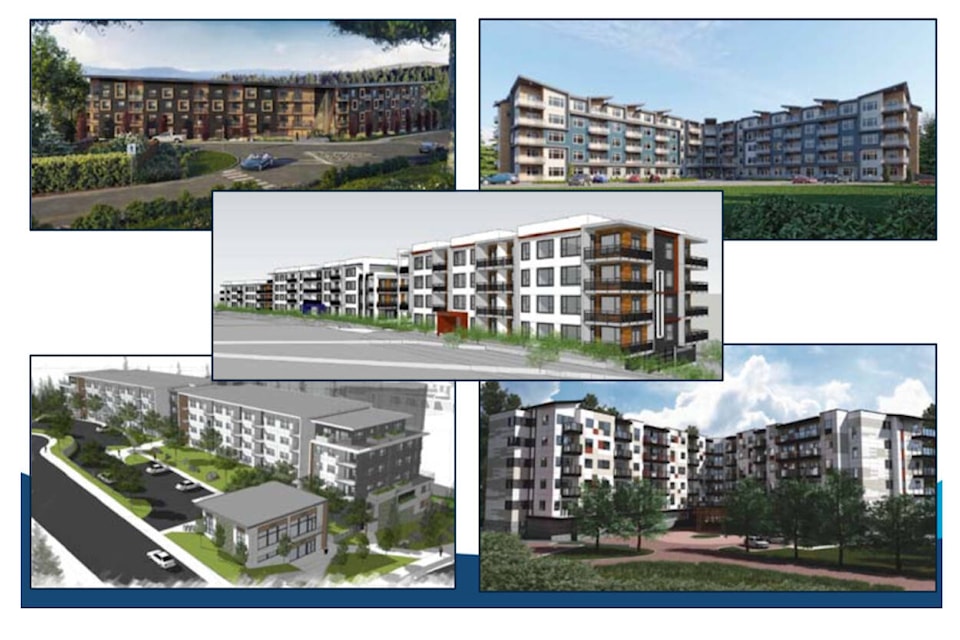The value of Nanaimo’s building permit applications took an upward swing last year, amounting to more than $400 million.
According to a city press release, the $410 million total value of building permits was the second highest on record, bested only by 2019’s figure of $445 million.
Applications for residential units led the way last year with building permits issued for 1,370 units, of which 1,065 were in multi-unit developments.
Highlights cited in the release include an 87-unit project at 560 Brechin Rd. overlooking the Departure Bay B.C. Ferries terminal; a mixed-use development with 98 residential units at 4831 Cedar Ridge Pl. near Long Lake; and a 160-unit seniors care residence at4979 Wills Rd., also located at the north end of Long Lake. A $29-million, five-storey, 152-unit project is also under construction at 6020 Linley Valley Dr.
Secondary suites and carriage houses at single-family home properties accounted for 152 building permits granted.
In his presentation to city council on Monday, March 6, Dale Lindsay, general manager of development services, said the story the past two years has been one of “strong growth.”
“You saw in 2021, Nanaimo was one of the fastest-growing places in Canada … for 2022 that trend is continuing,” he said. “What you’re going to see is a story about major investments in our town centres, including in our downtown. This is right on the heels of our city plan, which focuses growth around our town centres.”
Lindsay said Nanaimo is trending, as a community, away from single-family homes and urban sprawl to multi-family residential construction and in-fill and redevelopment of existing properties with “significant private investment” to create housing.
Over the past 10 years, 60 per cent of new single-family homes have included secondary suites. In 2022, 65 per cent of new homes included secondary suites. Construction of multi-family residences, secondary suites, and carriage homes outpaced single-family construction in 2022. Sixty-four per cent of all multi-family permits are for apartment buildings.
“We know that over the next 10 years we need to build about 1,400 units a year to meet the 10-year demand, so [for] 2022 we’re almost right on that mark of what we see we need to do, on average, for the next decade,” Lindsay said.
Building permits currently under review include residential projects that will bring hundreds of living units to downtown Nanaimo at 235 Wallace St., 388 Machleary St., 6340 McRobb Ave. and 340 Campbell St.
Coun. Ian Thorpe asked about commercial project construction, wondering if the city’s growing population would create increased demand or growth in the commercial sector, as well.
Lindsay said commercial project applications have trended “fairly consistently,” but the value of a single commercial project application can skew statistics.
“We do see it going up and down a little bit…” he said. “A $50-million project can look like it’s shooting the stats way up, so you kind of have to dig down a little bit about what’s driving it. I would say a lot of what you’re seeing … is a lot of investment in older commercial spaces … retrofitting – bringing those up to current standards – as much as new commercial, but certainly, I think, as we densify these areas, yes, there’s going to be a need for more commercial.”
Lindsay said the city is hearing about the need for more office space in some town centres that has not been added over the past 10 to 20 years.
READ ALSO: Nanaimo reimagined with new city plan
The city’s stated long-term vision is for more complete neighbourhoods with access to services linked by transportation corridors and public transit, as confirmed through public consultation for Reimagine Nanaimo.
“Our population is growing and our housing options are growing with it,” said Nanaimo Mayor Leonard Krog in the press release. “With more and more housing concentrated in areas where people can easily access shopping, services and employment, we are becoming a more vibrant urban centre. By growing up, rather than out, Nanaimo is protecting green spaces and natural areas and providing housing options that more people can afford.”
READ ALSO: City of Nanaimo urged to expand its boundaries
chris.bush@nanaimobulletin.com
Like us on Facebook and follow us on Twitter
